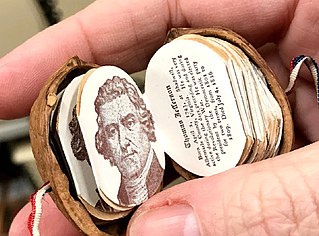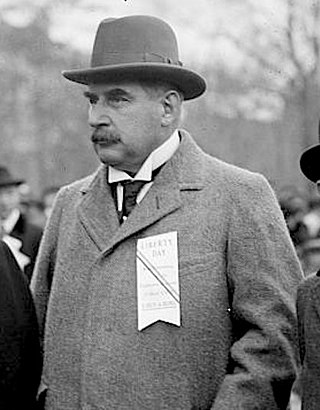
A book is a medium for recording information in the form of writing or images. Books are typically composed of many pages, bound together and protected by a cover. Modern bound books were preceded by many other written mediums, such as the codex and the scroll. The book publishing process is the series of steps involved in their creation and dissemination.

Rubáiyát of Omar Khayyám is the title that Edward FitzGerald gave to his 1859 translation from Persian to English of a selection of quatrains attributed to Omar Khayyam (1048–1131), dubbed "the Astronomer-Poet of Persia".
This article contains information about the literary events and publications of 1912.
This article contains information about the literary events and publications of 1940.

The St Cuthbert Gospel, also known as the Stonyhurst Gospel or the St Cuthbert Gospel of St John, is an early 8th-century pocket gospel book, written in Latin. Its finely decorated leather binding is the earliest known Western bookbinding to survive, and both the 94 vellum folios and the binding are in outstanding condition for a book of this age. With a page size of only 138 by 92 millimetres, the St Cuthbert Gospel is one of the smallest surviving Anglo-Saxon manuscripts. The essentially undecorated text is the Gospel of John in Latin, written in a script that has been regarded as a model of elegant simplicity.

The Kelmscott Press, founded by William Morris and Emery Walker, published 53 books in 66 volumes between 1891 and 1898. Each book was designed and ornamented by Morris and printed by hand in limited editions of around 300. Many books were illustrated by Edward Burne-Jones. Kelmscott Press books sought to replicate the style of 15th-century printing and were part of the Gothic revival movement. Kelmscott Press started the contemporary fine press movement, which focuses on the craft and design of bookmaking, often using hand presses. While their most famous books are richly decorated, most Kelmscott Press books did not have elaborate decoration, but were published simply.

St George's Hall is a building on St George's Place, opposite Lime Street railway station in the centre of Liverpool, England. Opened in 1854, it is a Neoclassical building which contains concert halls and law courts, and is recorded in the National Heritage List for England as a designated Grade I listed building. On the east side of the hall, between it and the railway station, is St George's Plateau and on the west side are St John's Gardens. The hall is included in the William Brown Street conservation area.

A miniature book is a very small book. Standards for what may be termed a miniature rather than just a small book have changed through time. Today, most collectors consider a book to be miniature only if it is 3 inches or smaller in height, width, and thickness, particularly in the United States. Many collectors consider nineteenth-century and earlier books of 4 inches to fit in the category of miniatures. Book from 3–4 inches in all dimensions are termed macrominiature books. Books less than 1 inch in all dimensions are called microminiature books. Books less than 1/4 inch in all dimensions are known as ultra-microminiature books.

John Pierpont Morgan Jr. was an American banker, finance executive, and philanthropist. He inherited the family fortune and took over the business interests including J.P. Morgan & Co. after his father J. P. Morgan died in 1913.

A treasure binding or jewelled bookbinding is a luxurious book cover using metalwork in gold or silver, jewels, or ivory, perhaps in addition to more usual bookbinding material for book covers such as leather, velvet, or other cloth. The actual bookbinding technique is the same as for other medieval books, with the folios, normally of vellum, stitched together and bound to wooden cover boards. The metal furnishings of the treasure binding are then fixed, normally by tacks, onto these boards. Treasure bindings appear to have existed from at least Late Antiquity, though there are no surviving examples from so early, and Early Medieval examples are very rare. They were less used by the end of the Middle Ages, but a few continued to be produced in the West even up to the present day, and many more in areas where Eastern Orthodoxy predominated. The bindings were mainly used on grand illuminated manuscripts, especially gospel books designed for the altar and use in church services, rather than study in the library.

Ivory carving is the carving of ivory, that is to say animal tooth or tusk, generally by using sharp cutting tools, either mechanically or manually. Objects carved in ivory are often called "ivories".

The Ashendene Press was a small private press founded by St John Hornby (1867–1946). It operated from 1895 to 1915 in Chelsea, London and was revived after the war in 1920. The press closed in 1935. Its peers included the Kelmscott Press and the Doves Press. Hornby became friends with William Morris and Emery Walker, who helped inspire his work. These three presses were part of a "revival of fine printing" that focused on treating bookmaking as fine art. The Ashendene Press was famous for producing high-quality works by Dante. Ashendene books had excellent bindings and focused more on pleasure than reform than the other private presses of the time, though one review claims that the Ashendene Press was the most successful private press in recapturing the essence of fifteenth-century printing. Ashendene books were carefully printed with large margins, and despite their lack of extravagant decoration, they were considered spectacular works of art. Two original typefaces were created for the Ashendene Press: Subiaco and Ptolemy. They were known for handwritten, colored initials by Graily Hewitt. The press' main customers were book collectors who paid for a subscription for Ashendene books.
Roger Powell was an English bookbinder.
The conservation and restoration of illuminated manuscripts is the care and treatment of illuminated manuscripts which have cultural and historical significance so that they may be viewed, read, and studied now and in the future. It is a specialty case of the conservation and restoration of parchment within the field of conservation and restoration of books, manuscripts, documents and ephemera.

Bookbinding is the process of building a book, usually in codex format, from an ordered stack of paper sheets with one's hands and tools, or in modern publishing, by a series of automated processes. Firstly, one binds the sheets of papers along an edge with a thick needle and strong thread. One can also use loose-leaf rings, binding posts, twin-loop spine coils, plastic spiral coils, and plastic spine combs, but they last for a shorter time. Next, one encloses the bound stack of paper in a cover. Finally, one places an attractive cover onto the boards, and features the publisher's information and artistic decorations.

The Lindau Gospels is an illuminated manuscript in the Morgan Library in New York, which is important for its illuminated text, but still more so for its treasure binding, or metalwork covers, which are of different periods. The oldest element of the book is what is now the back cover, which was probably produced in the later 8th century in modern Austria, but in the context of missionary settlements from Britain or Ireland, as the style is that of the Insular art of the British Isles. The upper cover is late Carolingian work of about 880, and the text of the gospel book itself was written and decorated at the Abbey of Saint Gall around the same time, or slightly later.

Edith Diehl was an American bookbinder and author of Bookbinding, its Background and Technique, a classic text and manual on the history and craft of bookbinding in two volumes. In 1947, in recognition of her accomplishments, Diehl was made an Honorary Life Member of the Guild of Book Workers.
Rosamond Bowditch Loring was an author, bookbinder, and creator, collector and historian of decorated papers. She was active in publishing circles as well as craft organizations. Her collection of historic and modern papers, now housed at Harvard University, is still used by librarians, book publishers, collectors, and researchers.
Douglas Bennett Cockerell was a British bookbinder and author.
John Harrison Stonehouse was an English bookseller and Charles Dickens scholar at long-established London booksellers Sotheran's where he rose from apprentice to managing director through hard work and a strong entrepreneurial instinct. He introduced and popularised the "Cosway" binding and commissioned the opulent edition of Edward FitzGerald's The Rubaiyat of Omar Khayyam that was lost when RMS Titanic sank in 1912. He published a book on the subject in 1933.













